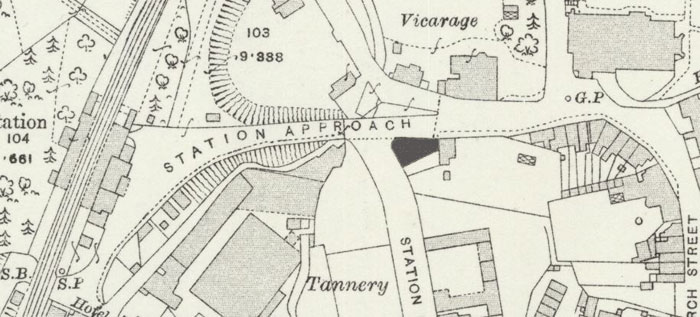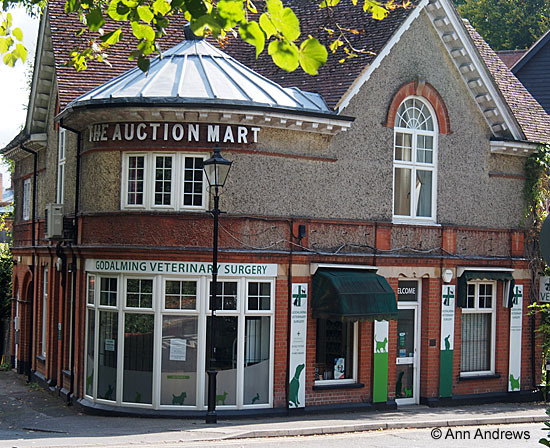The card's sender commented: "[I] have been up this road a good many times very good view it is you can turn off where the man
is standing to go to the dentist". Whilst we cannot quite see the station on this early twentieth century card, the curving
approach to it is recognisable today. A row of cabs are lined up on its right, awaiting passengers.
Most of the buildings shown here are extant. On the left is a late nineteenth century structure, constructed largely of
red brick, that is still known as the Auction Mart. The upper floor of the two sides of the house that then faced the road and
the station were covered with pebble dash; it would have been used here for decorative effect.
Westbrook Road goes off to the right, with Brook Cottage on the bend. It is said to have been a lodge-keeper's cottage for Westbrook
Place[1], and later housed railway workers[2].
On the hillside to the right of the cottage are two white notices attached to the fence of the station platform. The vicarage is
on the far right; it is now privately owned.
The Auction Mart was first mentioned on Railway Approach in 1900[3]. The following year Messrs.
Folker & Horton placed an advertisement stating they undertook of valuations and sales of "landed estates, residences, farming stock,
timber, furniture, nursery stock and other effects". They were advertising a property auction at their premises, "known as Auction Mart"
on Railway Approach, at the time[4]. The firm was still trading there in 1954[5].
Joseph Edward Sparkes, a land and estate agent, had an office in the building in 1913[6]. In 1939
Ronald de Bruyn, a Veterinary Surgeon, lived in part of the Auction Mart building with his wife[2].
Although the road layout nearby changed over the years, for a long time the Westbrook Road/Station Approach junction was unaffected.
Station Road was constructed about 1912, and extended from Station Approach to Mint Street[7]. It
joined the Approach on the far side of the Auction Mart, as the map below shows. In the photograph, above, it was where light is shining
across the road (behind the woman carrying two baskets).

1913 OS map showing northern end of the newly created Station Road.
The Auction Mart building has been coloured dark grey so it stands out.
Next to it was the single storey building, probably all or part of the stables[8], attached to the house.
The road layout was still the same in 1968, although Thomas Rea's Tannery was described as "works" and was eventually replaced
by offices.
A map in the Godalming Trust's "A Godalming Walk" produced in the 1970s draws attention to the building[1]:
"Notice ... the Auction Mart, built on a difficult, acute-angle site. Its little turret can be seen elsewhere in Godalming (on the
Corner of Meadrow and Catteshall Road)."
The little turret the Trust mentions is on the far end of the building, facing the station, and cannot be seen on the postcard. However, since
then there have been a number of changes to both the station access and the Auction Mart's plot. The wall and single storey building on the far left,
either side of where the man is walking through, were demolished. However, where it joined the main building on the eastern side of the property
can still be seen as the brickwork on that side stops below first floor level.
These days, instead of Station Approach leading directly to the station, a wall now blocks the road and parking for the vets has been created
behind it. A footpath is all that connects here with the station. The road past the Auction Mart was diverted to the southern side of the building,
curving across what had been the garden and creating an additional section of Station Road. What was the back of the building now faces the
road. It left the Auction Mart on a small island of land, surrounded by roads.

The Auction Mart in 2024. The large windows would have been the Mart's showrooms in earlier times and would have been the first commercial
premises that commuters would have seen when they walked into Godalming having alighted from the train.
In 1997 there was an application for a change of use and what had been offices became a veterinary practice with a residential unit above it.
Very recently the local authority have created a different system to access the station, with traffic now arriving via the very narrow Mill
Lane and leaving via Station Road. The Approach now has pavements on both sides of the road so can only take one lane of vehicles.
|